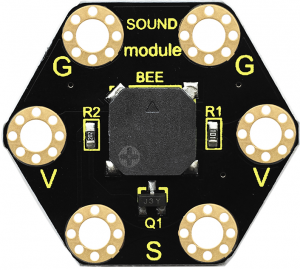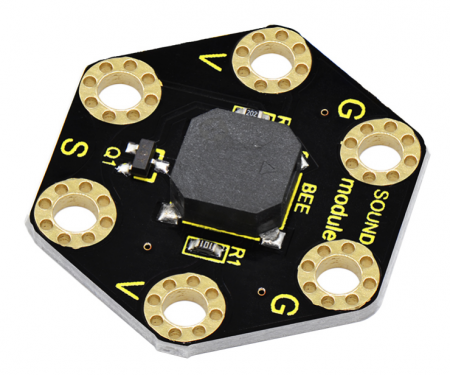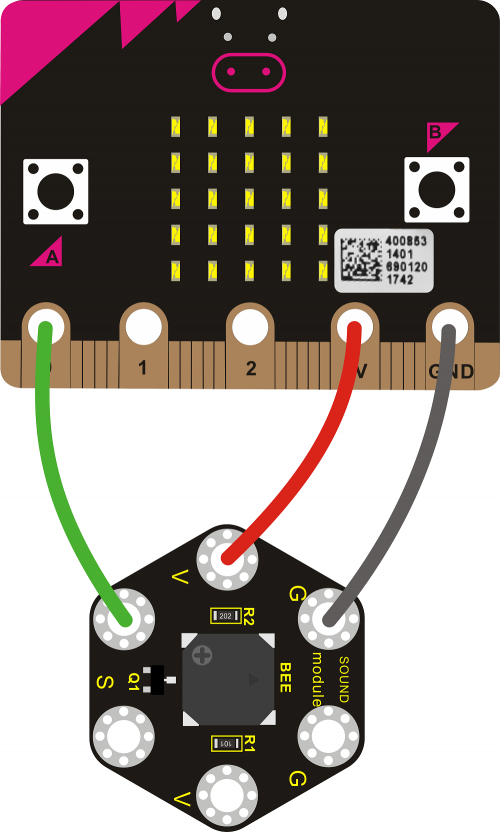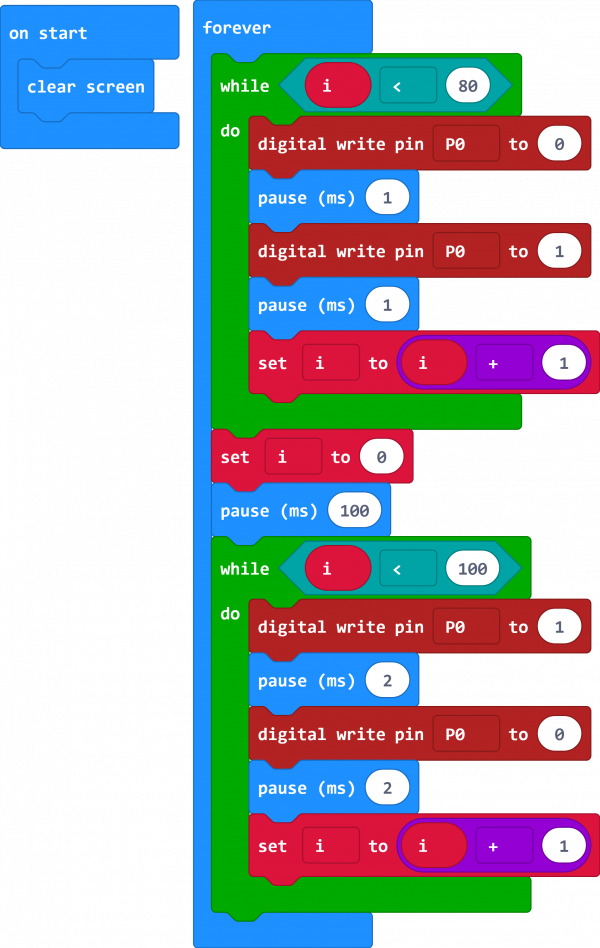Ks0424 keyestudio micro:bit Passive Buzzer Module: Difference between revisions
Keyestudio (talk | contribs) No edit summary |
Keyestudio (talk | contribs) |
||
| (11 intermediate revisions by the same user not shown) | |||
| Line 1: | Line 1: | ||
[[image:Ks0424-1.png|thumb|300px|right|keyestudio Passive Buzzer Module For BBC micro:bit]] | |||
[[image: | |||
<br> | <br> | ||
==Description== | ==Description== | ||
There are total 6 rings on the module. Note that two G rings, two V rings and two S rings are | This Keyestudio passive buzzer module is fully compatible with micro:bit control boards.<br> | ||
Composed of a passive buzzer without oscillation circuit, it cannot be actuated by itself, but by external pulse frequencies. | |||
When using, connect | Different frequencies produce different sounds as well as the melody of a song.<br> | ||
<br> | There are total 6 gold-plated rings on the module. Note that two G rings, two V rings and two S rings are connected. G is for ground; V for 3V; S for signal pin(0 1 2).<br> | ||
When using it, you need to connect it to a micro:bit control board through crocodile clip lines.<br> | |||
<br> | <br> | ||
== Technical Parameters == | == Technical Parameters == | ||
* Working voltage: DC 3.0-3.3V | * Working voltage: DC 3.0-3.3V | ||
* Output signal: | * Output signal: Digital signal (square wave) | ||
* Dimensions: 31mm*27mm* | * Dimensions: 31mm*27mm*4.5mm | ||
* Weight: | * Weight: 2.3g | ||
* Environmental attributes: ROHS | * Environmental attributes: ROHS | ||
<br>[[File: | <br>[[File:Ks0424-2.png|450px|frameless|thumb]]<br> | ||
<br> | <br> | ||
== Connection Diagram== | == Connection Diagram== | ||
[[File: | [[File:Ks0424-3.png|500px|frameless|thumb]]<br> | ||
<br> | <br> | ||
== Source Code == | == Source Code == | ||
[[File: | <br> | ||
'''Code 1:''' <br> | |||
<br>[[File:Ks0424-4.png|600px|frameless|thumb]]<br> | |||
<br> | |||
'''Code 2:''' <br> | |||
<br>[[File:Ks0424-5.png|600px|frameless|thumb]]<br> | |||
<br> | <br> | ||
<span style=color:red> '''Note:''' </span><br> | |||
If you drag the source code we provided to the Microsoft MakeCode Block editor https://makecode.microbit.org/#editor | |||
Click the icon [[File:361 7-6-8.png|500px|frameless|thumb]] , you can check the frequency of each tone as follows: | |||
<br>[[File:Ks0424-7.png|600px|frameless|thumb]]<br> | |||
<br> | |||
== Example Result == | == Example Result == | ||
Connect well the module, then send the source code to the micro:bit main board. | Connect well the module, then send the source code to the micro:bit main board.<br> | ||
<br> | If send the code 1, the buzzer will alternately make two sounds.<br> | ||
If send the code 2, the buzzer will play a song of Ode To Joy. | |||
<br> | <br>[[File:Ks0424-8.png|600px|frameless|thumb]]<br> | ||
<br> | <br> | ||
==Resources == | |||
<br>[[ | |||
*'''Download relevant datasheet and code: | |||
''' https://fs.keyestudio.com/KS0424 | |||
* [http://microbit.org/ BBC micro:bit website ] <br> | |||
* [https://makecode.microbit.org/ Micro:bit MakeCode Block Editor ]<br> | |||
* [http://microbit.org/guide/ Meet micro:bit starter programming] <br> | |||
* [http://microbit.org/guide/features/ BBC micro:bit Features Guide ] <br> | |||
* [http://microbit.org/guide/features/ BBC micro:bit Safety Warnings ] <br> | |||
* [http://microbit.org/guide/quick/ BBC micro:bit Quick Start Guide ] <br> | |||
* [http://microbit.org/guide/hardware/pins/ BBC micro:bit Pins ] | |||
<br> | <br> | ||
== | ==Get One Now== | ||
*[https://www.aliexpress.com/store/product/Keyestudio-Passive-Buzzer-Sound-Module-For-BBC-micro-bit/1452162_32999037060.html?spm=2114.12010611.8148356.17.3f896c0eHzY5BG Shop on aliexpress ] | |||
*[https://www.keyestudio.com/keyestudio-passive-buzzer-sound-module-for-bbc-microbit-p0539-p0539.html Official website] | |||
[[Category: Micro:bit]] | |||
Latest revision as of 16:33, 30 June 2021
Description
This Keyestudio passive buzzer module is fully compatible with micro:bit control boards.
Composed of a passive buzzer without oscillation circuit, it cannot be actuated by itself, but by external pulse frequencies.
Different frequencies produce different sounds as well as the melody of a song.
There are total 6 gold-plated rings on the module. Note that two G rings, two V rings and two S rings are connected. G is for ground; V for 3V; S for signal pin(0 1 2).
When using it, you need to connect it to a micro:bit control board through crocodile clip lines.
Technical Parameters
- Working voltage: DC 3.0-3.3V
- Output signal: Digital signal (square wave)
- Dimensions: 31mm*27mm*4.5mm
- Weight: 2.3g
- Environmental attributes: ROHS
Connection Diagram
Source Code
Note:
If you drag the source code we provided to the Microsoft MakeCode Block editor https://makecode.microbit.org/#editor
Click the icon ![]() , you can check the frequency of each tone as follows:
, you can check the frequency of each tone as follows:
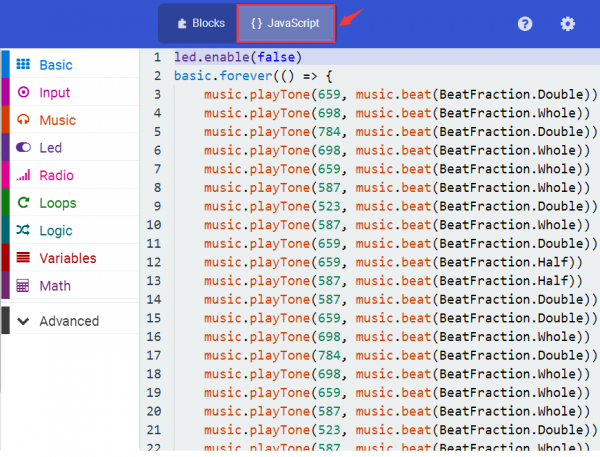
Example Result
Connect well the module, then send the source code to the micro:bit main board.
If send the code 1, the buzzer will alternately make two sounds.
If send the code 2, the buzzer will play a song of Ode To Joy.
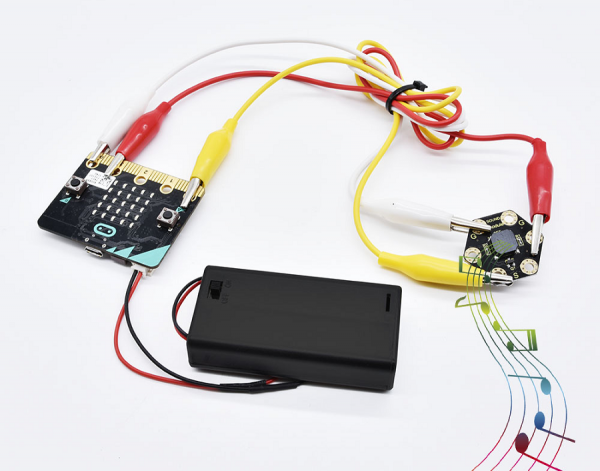
Resources
- Download relevant datasheet and code:
https://fs.keyestudio.com/KS0424
- BBC micro:bit website
- Micro:bit MakeCode Block Editor
- Meet micro:bit starter programming
- BBC micro:bit Features Guide
- BBC micro:bit Safety Warnings
- BBC micro:bit Quick Start Guide
- BBC micro:bit Pins
